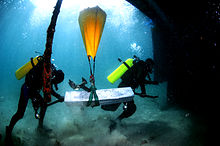Lifting bag

Israeli Navy Underwater Missions Unit transfers equipment using lifting-bags
|
|
| Uses | Lifting heavy objects underwater |
|---|---|
A lifting bag is an item of diving equipment consisting of a robust and air-tight bag with straps, which is used to lift heavy objects underwater by means of the bag's buoyancy. The heavy object can either be moved horizontally underwater by the diver or sent unaccompanied to the surface.
Lift bag appropriate capacity should match the task at hand. If the lift bag is grossly oversized a runaway or otherwise out of control ascent may result. Commercially available lifting bags may incorporate dump valves to allow the operator to control the buoyancy during ascent, but this is a hazardous operation with high risk of entanglement in an uncontrolled lift or sinking. If a single bag is insufficient, multiple bags may be used, and should be distributed to suit the load.
There are also lifting bags used on land as short lift jacks for lifting cars or heavy loads or lifting bags which are used in machines as a type of pneumatic actuator which provides load over a large area. These lifting bags of the AS/CR type are for example used in the brake mechanism of rollercoasters.
The volume of the bag determines its lifting capacity: each litre of air inside the bag will lift a weight of 1 kilogram, or each cubic foot will lift about 62 pounds. For example, a 100-litre (3.5 cu ft) bag can lift a 100-kilogram (220 lb) underwater object.
A partially filled bag will accelerate as it ascends because the air in the bag expands as the pressure reduces on the ascent, following Boyles law, increasing the bag's buoyancy, whereas a full bag will overflow or blow off excess volume and maintain the same volume and buoyancy providing is does not descend. A bag which leaks sufficiently to start sinking will lose volume to compression and become less buoyant in a positive feedback loop until stopped by the bottom.
The force required to lift a submerged object from the bottom can be split into two main components:
Once the object has broken free of the bottom, only the apparent weight remains, and a controlled lift requires a way of managing the sudden decrease of resistance to the lifting force. There are three basic ways this can be done:
Once a load is lifted off the substrate, it will rotate until the centre of gravity is in the position of lowest potential energy. If it is suspended from a single point, the apparent centre of gravity (corrected for inherent buoyancy) will be directly below the lift point. If it is undesirable for the load to rotate by a large angle as it leaves the bottom, the lifting point must be chosen to allow for this effect, and a multi-part sling or spreader bar may be needed, and it may be necessary to secure slings so they do not slip.
...
Wikipedia
